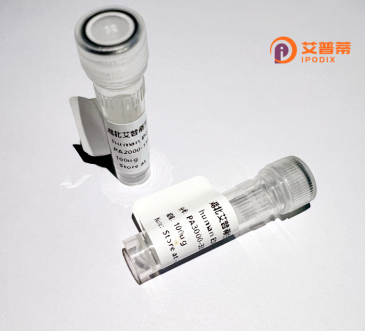
| 纯度 | >90%SDS-PAGE. |
| 种属 | Human |
| 靶点 | NOP5 |
| Uniprot No | Q9Y2X3 |
| 内毒素 | < 0.01EU/μg |
| 表达宿主 | E.coli |
| 表达区间 | 1-529 aa |
| 活性数据 | MLVLFETSVGYAIFKVLNEKKLQEVDSLWKEFETPEKANKIVKLKHFEKFQDTAEALAAFTALMEGKINKQLKKVLKKIVKEAHEPLAVADAKLGGVIKEKLNLSCIHSPVVNELMRGIRSQMDGLIPGVEPREMAAMCLGLAHSLSRYRLKFSADKVDTMIVQAISLLDDLDKELNNYIMRCREWYGWHFPELGKIISDNLTYCKCLQKVGDRKNYASAKLSELLPEEVEAEVKAAAEISMGTEVSEEDICNILHLCTQVIEISEYRTQLYEYLQNRMMAIAPNVTVMVGELVGARLIAHAGSLLNLAKHAASTVQILGAEKALFRALKSRRDTPKYGLIYHASLVGQTSPKHKGKISRMLAAKTVLAIRYDAFGEDSSSAMGVENRAKLEARLRTLEDRGIRKISGTGKALAKTEKYEHKSEVKTYDPSGDSTLPTCSKKRKIEQVDKEDEITEKKAKKAKIKVKVEEEEEEKVAEEEETSVKKKKKRGKKKHIKEEPLSEEEPCTSTAIASPEKKKKKKKKRENED |
| 分子量 | 86 kDa |
| 蛋白标签 | GST-tag at N-terminal |
| 缓冲液 | 0 |
| 稳定性 & 储存条件 | Lyophilized protein should be stored at ≤ -20°C, stable for one year after receipt. Reconstituted protein solution can be stored at 2-8°C for 2-7 days. Aliquots of reconstituted samples are stable at ≤ -20°C for 3 months. |
| 复溶 | Always centrifuge tubes before opening.Do not mix by vortex or pipetting. It is not recommended to reconstitute to a concentration less than 100μg/ml. Dissolve the lyophilized protein in distilled water. Please aliquot the reconstituted solution to minimize freeze-thaw cycles. |
以下是关于重组人NOP5/NOP56蛋白的模拟参考文献示例(部分名称可能涉及相关同源蛋白):
1. **"Structural insights into the NOP56/58 complex in snoRNP assembly"**
*作者:Chen Y. et al.*
摘要:研究通过重组表达人NOP56和NOP58蛋白,解析了其在snoRNP复合物中的相互作用结构,揭示了其在rRNA甲基化中的关键作用。
2. **"Recombinant NOP5 facilitates in vitro snoRNA binding and rRNA processing"**
*作者:Mendoza J.A. et al.*
摘要:报道了重组人NOP5蛋白的表达与功能验证,证明其与snoRNA结合并参与前体rRNA的加工过程。
3. **"Functional characterization of recombinant human NOP56 in ribosome biogenesis"**
*作者:Lee S. & Kim H.*
摘要:通过体外实验验证重组NOP56蛋白在核糖体组装中的必要性,并探讨其突变与遗传性疾病的相关性。
4. **"Dynamic assembly of the box C/D snoRNP complex mediated by NOP5"**
*作者:Gagnon K.T. et al.*
摘要:利用重组NOP5蛋白研究其在C/D盒snoRNP动态组装中的调控机制,揭示其分子伴侣功能。
**注**:NOP5可能与NOP56/58存在命名混淆,建议根据实际研究目标核对蛋白命名或补充关键词(如snoRNP、rRNA加工)。如需具体文献,可进一步限定研究领域或修正蛋白名称。
Recombinant human NOP5 (Nucleolar Protein 5) is a conserved eukaryotic protein involved in ribosome biogenesis, a critical process for cell growth and proliferation. NOP5. also known as NOP56 in some contexts, is a core component of the box C/D small nucleolar ribonucleoprotein (snoRNP) complex, which guides site-specific 2'-O-methylation of ribosomal RNA (rRNA) during rRNA precursor maturation. This post-transcriptional modification is essential for ribosomal subunit assembly and translational fidelity.
Structurally, NOP5 contains an α-helical N-terminal domain and a conserved C-terminal domain that interacts with other snoRNP components, including fibrillarin and the non-coding snoRNA. Recombinant versions are typically produced in bacterial or eukaryotic expression systems for functional studies. Researchers utilize recombinant NOP5 to investigate ribosomopathies, cancer biology (as nucleolar proteins are frequently dysregulated in tumors), and viral mechanisms that hijack host ribosome synthesis. Its recombinant form enables biochemical characterization of snoRNP assembly, methylation mechanisms, and potential therapeutic targeting. Recent studies also explore its role in cellular stress responses and links to developmental disorders. The protein's conserved nature across species makes it valuable for comparative evolutionary studies of ribosome biogenesis pathways.
×